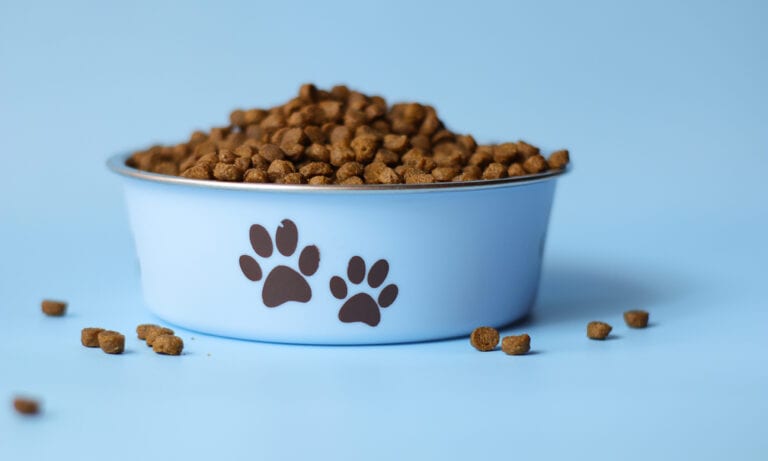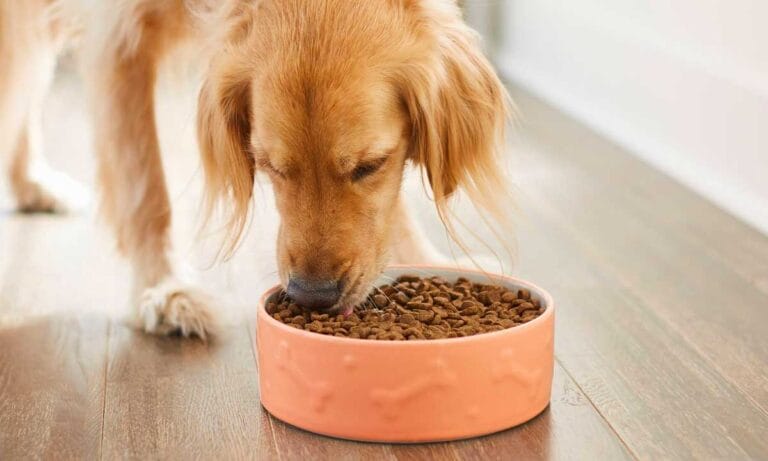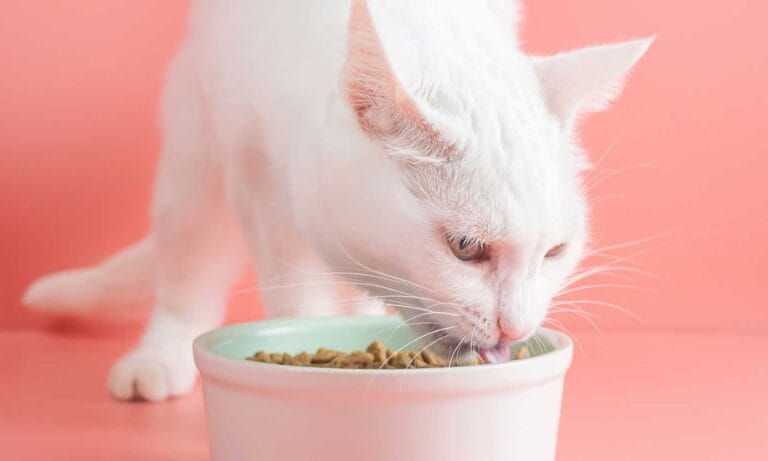Not sure what to do with that giant bag of kibble taking space in your kitchen? Rather than pushing it into a corner or cursing it every time your trip over it, there are more creative ways to store your pet’s food.
Here are find five stylish ways to get food out of sight while keeping it fresh.
Repurpose a Trash Can
A metal or plastic trash can be a great makeshift container to hide a bag of dog food, especially if you buy large bags that don’t seem to fit in anything else.
When choosing a trash can to store dog food, make sure the lid fits tightly and that it can’t be easily opened by a smart dog.
“If your dog is clever and can flip open a door handle, don’t get something similarly designed,” says Amy Trager, a certified professional organizer. “Does your dog knock things over? Get something with a locking lid.”
Next, decorate the can based on where you plan to keep it.
“If you have it in the middle of a room, consider painting it the same color as the walls to blend in,” says Trager. “Or, pick a bright, contrasting color to create a decorative but functional accent piece.”
No matter what method you use, make sure the bag is stored safely inside the house.
“Dog food should be stored in a dry and cool place,” says Dr. Carol Osborne, an integrative veterinarian and owner of Chagrin Falls Veterinary Center & Pet Clinic. “A pantry or cupboard, but not your garage, where temperatures can vary extremely.”
Once you’re ready to store the food, keep it inside the bag and place the entire bag in the container.
“Instead of dumping the dog food into the storage containers, place the entire bag full of food in, roll the top of the bag and keep it clamped shut,” says Osborne. “That way you are giving your dog’s food double protection from the elements.”
Cover a Plastic Container
Plastic can be sturdy but not super attractive, says Trager, so getting creative is key for a container that is going to be seen.
“You can certainly get paint that works on plastic, but it can come out streaky at times,” says Trager. “Depending on the shape of the container, covering it in adhesive paper could work.”
For odd-shaped buckets and containers, it might be difficult to get paper to adhere properly, so Trager suggests forgetting complete coverage and instead focusing on details.
“Get paw print-shaped stickers or stamps and cover the container in a decorative pattern. It will still be plastic, but at least it will be a bit more festive and fun,” she says.
Pick Up an Old Piece of Furniture
For the perfect hiding place, nothing beats a piece of furniture. Unless you already have something you can use, start by searching at garage sales or second-hand stores for something the right size, such as an old cabinet or small dresser.
“Depending on its condition, you might have to do some minor repair work first, strip old paint or stain it,” says Juan Carlos Daetz, home organization and design expert at Max Warehouse.
Once the repair work is out of the way, paint the piece to match your other furniture or choose a fun, lively color and use it as an accent piece. Chalk paint is a great option, as it doesn’t require primer and can be applied directly on finished wood. If the piece has doors, you can slide the bags of food right in or place the bag into a large bin before putting it in the furniture. For drawers, you can be even more creative.
“Line a drawer or two with tin or, if you are not that handy, just find a couple of plastic containers at the store that will fit inside the drawers,” says Daetz.
Hide the Bag Away
If you have a nice, large wicker basket or hamper, hide a full bag of dog food inside of it.
“Just make sure it’s sturdy enough that when a heavy bag is placed inside, it won’t sag or buckle, compromising its structure,” says Trager.
No hamper? Don’t be afraid to try something different.
“To dress up a dog food bag, I found a lined burlap grain bag and vintage, wooden grain scoop in an antique mall,” says designer Mary Schulte, owner of the home design store Open Home. “I just drop the bag of pet food inside the burlap bag and secure it with a small rope.”
Whenever possible, find a container that’s large enough to accommodate the entire bag of food.
“The biggest mistake pet owners often make is removing the dog food from the original packaging and dumping it into a storage container,” says Osborne. “Dog food bags are designed to keep dog’s food fresh, dry, and free from humidity and bugs; it also contains useful information in the case of a dog food recall, like barcode, date, and batch code.”
Upcycle Tins and Cans
Holiday cookie cans and tins of popcorn can make great dog food containers, especially after a little redecoration. If you’re not sure where to start, certified professional organizer Helene Segura recommends paint.
“If you want to paint a metal can, you’ll want to use paint like Rustoleum, which is made for adhering to metal,” says Segura. “For any container, you can also use wallpaper, shelf paper, fabric, stencils, stickers or decoupage to jazz up your can.”
For a more unique look, Segura says you should follow one simple rule: If you can glue it down, you can use it for decorating.
“The Sunday comics, kids’ artwork, duplicate photographs,” says Segura. “You could go with a dog theme or beach theme, or match the décor of the room in which the container will sit.”
Keeping Food Safe
No matter where you store dog food, make sure it stays dry and fresh. When in doubt, Osborne recommends checking to make sure the food doesn’t have an “off” odor.
“Also look for signs of mold, moisture and bugs,” Osborne adds. “And pay attention to your dog: if he suddenly stops eating the food or turns up his nose, he is telling you something is wrong.”
Unopened cans of wet food can be stored in drawers or cupboards, and if you’re upcycling a piece of furniture, they can be kept there with dry food and other dog supplies so everything is in one place.
“Once the can is opened, the remaining food should be emptied out of the can and transferred into a Tupperware container with a lid,” says Osborne. “You should not leave opened cans of food in the fridge for risk of outside contamination.”

Diana Bocco is a full-time writer and adventurer, whose work has been published in DiscoveryChannel.com, Yahoo!, & Popular Mechanics.
Share:









